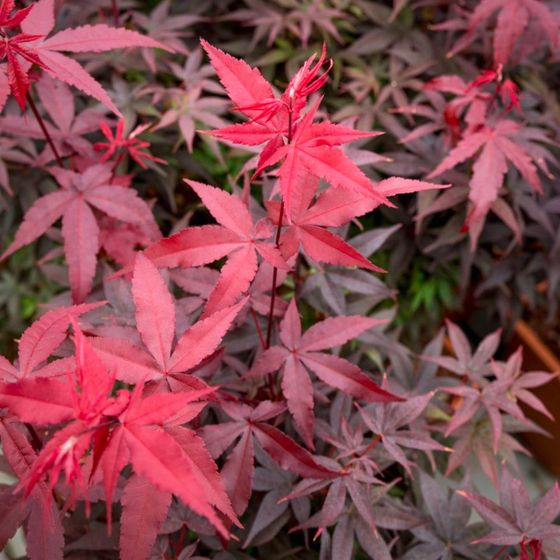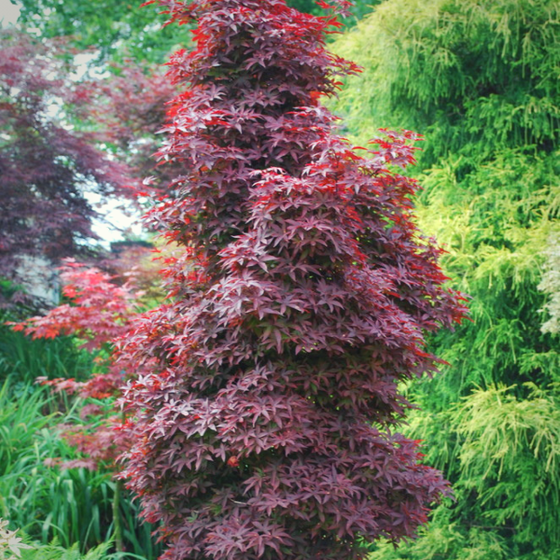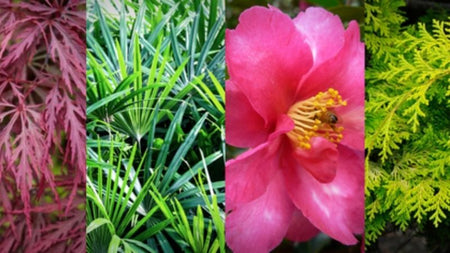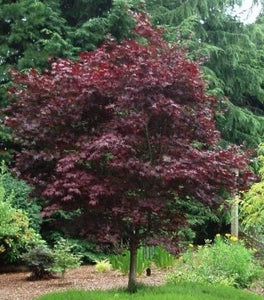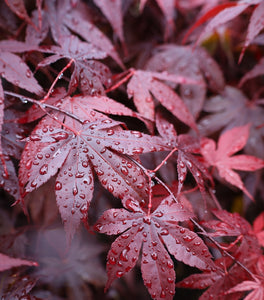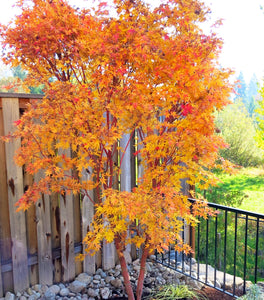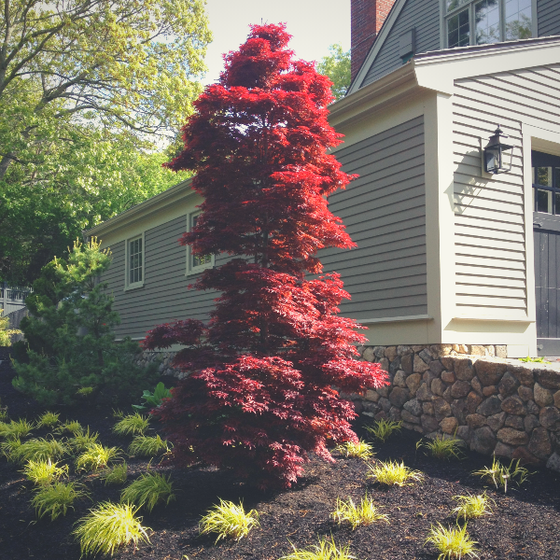
Images Depict Mature Plants
Twombly's Sentinel Japanese Maple for Sale Online
Twombly’s Red Sentinel Japanese Maple (Acer palmatum 'Twombly’s Red Sentinel') is a striking, upright, columnar tree known for its vibrant red foliage and narrow growth habit. Unique among Japanese maples, this cultivar stands out with its deep burgundy leaves that hold their rich color from spring through fall. Its tall, slender form—reaching 10 to 15 feet high and just 4 to 6 feet wide—makes it an exceptional choice for tight spaces, vertical accents, and small garden designs where height is desired without sacrificing ground space.
Perfect for modern landscapes, urban courtyards, and ornamental borders, Twombly’s Red Sentinel Japanese Maple thrives in full sun to partial shade and prefers well-drained, slightly acidic soil. Its low-maintenance nature and architectural silhouette make it ideal as a focal point in mixed garden beds or as an eye-catching specimen in large containers. In autumn, its red foliage deepens to a brilliant scarlet, offering four-season beauty that enhances patios, walkways, and foundation plantings.
Hardy in USDA Zones 5–9, this compact and elegant Japanese maple grows slowly, requiring minimal pruning to maintain its sculptural shape. Twombly’s Red Sentinel is also deer resistant and adapts well to sheltered sites, adding vertical interest and rich color to any landscape. Whether used to frame an entryway or add texture to a mixed shrub border, this distinctive tree delivers refined beauty and year-round appeal in even the smallest spaces.
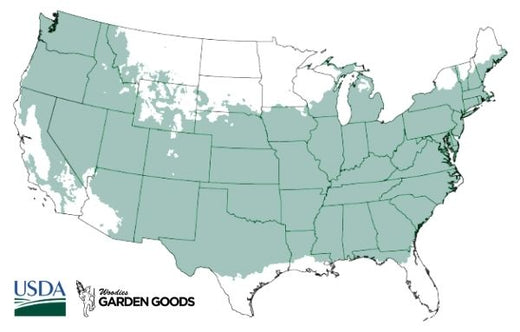
| Hardiness Zone: | 5-9 |
|---|---|
| Mature Height: | 10 to 15 Feet |
| Mature Width: | 4 to 6 Feet |
| Classification: | Small tree |
| Sunlight: | Full sun to part shade |
| Habit: | Deciduous, densely branched |
| Foliage: | Burgundy-red foliage that turns brilliant scarlet in fall |
| Soil Condition: | Any well-drained soil |
| Water Require: | Water well until established |
| Uses: | Extremely attractive when used as a focal point or a specimen planting |
How to Care for Twombly's Red Sentinel Japanese Maple
Be sure to read our planting instructions to ensure a healthy and happy Twombly's Red Sentinel Japanese Maple for years to come!
How do you plant Twombly's Red Sentinel Japanese Maple?
Planting Twombly’s Red Sentinel Japanese Maple (Acer palmatum 'Twombly’s Red Sentinel') begins with selecting the right location—this unique, columnar Japanese maple thrives in full sun to partial shade and prefers a sheltered site with protection from harsh afternoon sun and strong winds. Choose a spot with well-drained, slightly acidic soil, and avoid areas prone to standing water. Dig a hole twice as wide as the root ball and just as deep. Gently remove the maple from its container, loosen the roots, and place it in the hole so the top of the root ball sits level with the surrounding soil. Backfill with native soil mixed with compost and water deeply to help settle the roots. After planting, apply a 2–3 inch layer of mulch around the base of the tree to help retain soil moisture, suppress weeds, and regulate soil temperature. Be sure to keep the mulch a few inches away from the trunk to prevent rot. During the first growing season, water regularly to establish a strong root system. Twombly’s Red Sentinel Japanese Maple is a low-maintenance, upright ornamental tree that adds bold red foliage and vertical structure to patios, entryways, foundation plantings, and narrow garden beds. With proper planting and care, this stunning maple delivers lasting beauty and architectural interest to any landscape.
How should I water my Twombly's Red Sentinel Japanese Maple?
Watering Twombly’s Red Sentinel Japanese Maple properly is key to establishing healthy roots and maintaining its vibrant red foliage. During the first growing season, water deeply once or twice a week, depending on weather conditions, to keep the soil consistently moist but not waterlogged. Focus on watering at the base of the tree to ensure moisture reaches the root zone while minimizing the risk of fungal issues from wet foliage. Using a slow trickle or drip irrigation system allows water to penetrate deeply, encouraging a strong, drought-tolerant root system. Once established, Twombly’s Red Sentinel Japanese Maple is moderately drought tolerant but still benefits from consistent watering during dry spells or extreme heat, especially when planted in full sun. Apply a 2–3 inch layer of mulch around the base of the tree to help retain soil moisture and regulate temperature, being careful to keep mulch a few inches away from the trunk. Container-grown specimens may require more frequent watering due to faster soil drying. With proper watering, this elegant, upright maple will flourish, providing rich seasonal color and a graceful columnar presence in your landscape.
How should I fertilize my Twombly's Sentinel Japanese Maple?
Feeding your plants is probably the single most forgotten part of growing healthy long lasting plants. Maintaining a constant low level of fertility will keep your trees healthy throughout the year. Applying high levels of nitrogen (N) is not recommended. Avoid using high N lawn fertilizer on Japanese maples. Japanese maples look best and develop thicker stems when allowed to grow at a slower speed. Applying high amounts of nitrogen will cause excessively fast growth that will weaken the plant. Weak branches can lead to damage if you are located where icing during winter is a problem. Fertilizing your Japanese maple with the proper type of fertilizer should be done either in late winter while the ground is still cold, or after the last freeze in spring. I recommend using a slow or controlled release type fertilizer.

How and When should I Prune my Twombly's Red Sentinel Japanese Maple?
Pruning Twombly’s Red Sentinel Japanese Maple (Acer palmatum 'Twombly’s Red Sentinel') should be done with care to maintain its naturally upright, columnar form and vibrant red foliage. The best time to prune is in late winter to early spring while the tree is still dormant, before new growth begins. Start by removing any dead, damaged, or crossing branches to improve air circulation and overall health. Light shaping can be done to refine the tree’s silhouette, but avoid excessive pruning, as Japanese maples are slow growers and their form is a key feature. If needed, light summer pruning can be performed in mid- to late summer to correct shape or remove fast-growing vertical shoots that may distort the tree’s narrow profile. Always use sharp, clean tools to make precise cuts just above a node or branch collar. Avoid pruning in early spring during leaf emergence, as sap flow is high and cuts may bleed. With minimal, well-timed pruning, Twombly’s Red Sentinel will retain its elegant vertical habit, deliver rich color through the seasons, and serve as a standout feature in containers, entryways, or narrow landscape beds.

